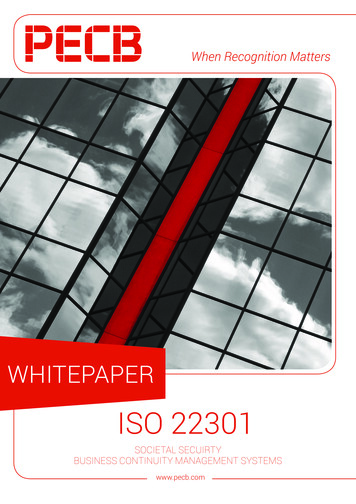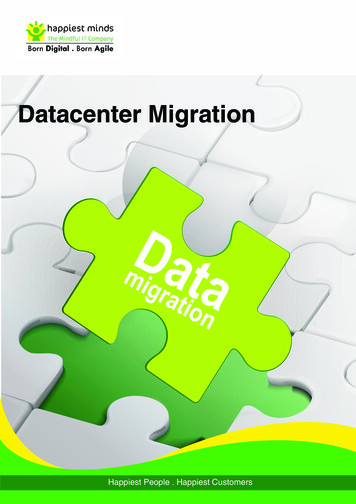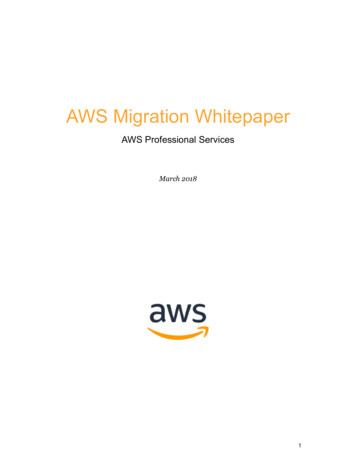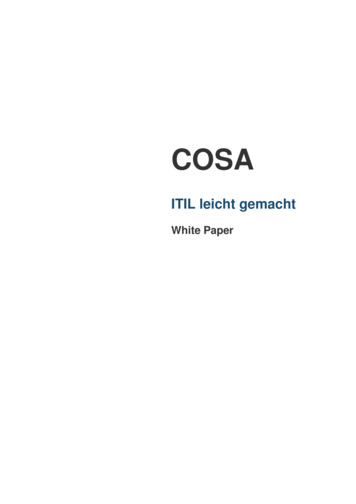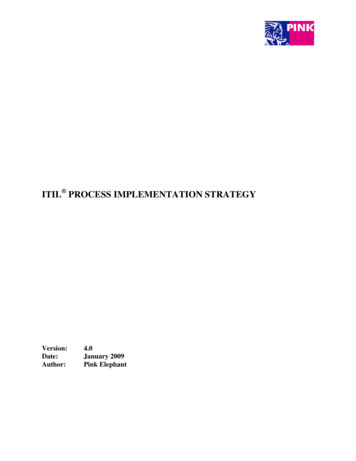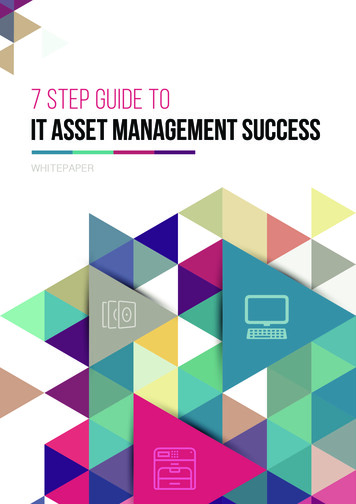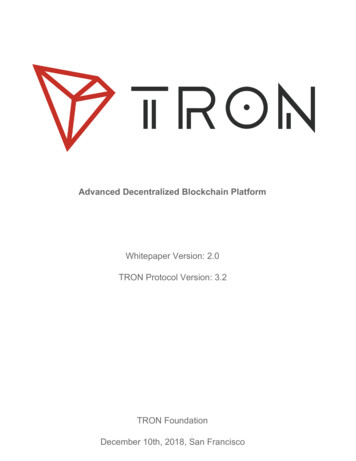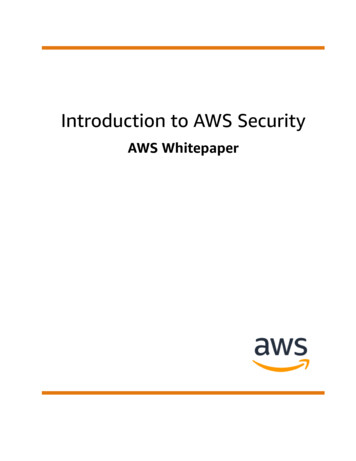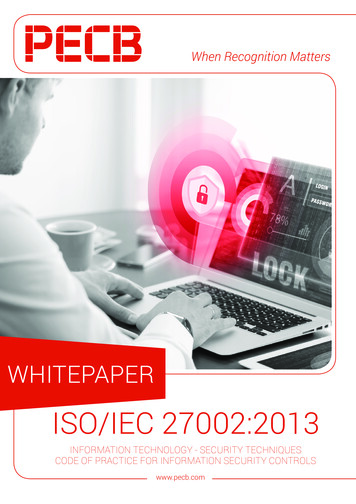
Transcription
When Recognition MattersWHITEPAPERISO/IEC 27002:2013INFORMATION TECHNOLOGY - SECURITY TECHNIQUESCODE OF PRACTICE FOR INFORMATION SECURITY CONTROLSwww.pecb.com
CONTENT3Introduction4An overview of ISO/IEC 27002:20135Relation between 27002 and 27001 and other standards6Key clauses of ISO/IEC 27002:20136Clause 5: Information Security Policies7Clause 6: Organization of Information Security7Clause 7: Human Resource Security7Clause 8: Asset Management7Clause 9: Access Control8Clause 10: Cryptography8Clause 11: Physical and Environmental Security8Clause 12: Operations Security9Clause 13: Communication Security9Clause 14: System Acquisition, Development and Maintenance9Clause 15: Supplier Relationships9Clause 16: Information Security Incident Management10Clause 17: Information Security Aspects of Business Continuity Management10Clause 18: Compliance10Code of Practice for Information Security Controls – The Business BenefitsPRINCIPAL AUTHORSEric LACHAPELLE, PECBMustafë BISLIMI, PECBEDITORS:Anders CARLSTEDT, Parabellum Cyber SecurityRreze HALILI, PECB2Published on February 26, 2016ISO/IEC 27002:2013 // INFORMATION TECHNOLOGY – SECURITY TECHNIQUES CODE OF PRACTICE FOR INFORMATION SECURITY CONTROLS
INTRODUCTIONThe Information Security standard ISO/IEC 27002:2013 is the “Code of Practice for Information SecurityControls”. First it was published by the International Organization for Standardization (ISO) and by theInternational Electro Technical Commission (IEC) in December 2000 as ISO 17799. Today, ISO/IEC 27002is part of the ISO27XXX series. The document provides best practice recommendations and guidance fororganizations selecting and implementing information security controls within the process of initiating,implementing and maintaining an Information Security Management System (ISMS).The establishment and implementation of an ISMS depends on a strategic orientation of the organizationand is influenced by a number of aspects including its needs, objectives, security requirements, theorganizational processes used, the size and the structure of the organization.An ISMS such as specified in ISO/IEC 27001 is an integrated part of organization’s processes and overallmanagement structure, with the main objective to ensure the necessary levels of confidentiality, integrityand availability of information. This objective is achieved by applying a supporting risk management processwithin the ISMS and by implementing a suite of information security controls as part of the risk treatmentunder the overall framework of a coherent management system.The normative requirements of ISMS are addressed in clauses 4 to 11 of 27001:2013 that define the ISMS.Furthermore, organizations need to consider the set of 144 controls which are found in Annex A of the samestandard.In ISO/IEC 27002, you will find more detailed guidance on the application of the controls of Annex A includingareas such as policies, processes, procedures, organizational structures and software and hardwarefunctions. All these information security controls may need to be established, implemented, monitored,reviewed and improved, where necessary, to ensure that the specific established security and businessobjectives of the organization are met.ISO/IEC 27002 provides general guidance on the controls of ISO 27001, and should be combined andused with other standards of the information security management system family of standards, includingISO/IEC 27003 (implementation), ISO/IEC 27004 (measurement), and ISO/IEC 27005 (risk management).ISO/IEC 27002:2013 // INFORMATION TECHNOLOGY - SECURITY TECHNIQUES - CODE OF PRACTICE FOR INFORMATION SECURITY CONTROLS3
Information and the need for its securityThe importance of information security and emerging threats has changed dramatically in the last eight years.Everyday information is being collected, processed, stored and transmitted in many forms including electronic, physical and verbal formats, within all types of organizations. All this is accomplished by using a hugerange of devices, systems and services including smartphones, tablets personal computers, servers, workstations, personal digital assistants, telecommunication network systems, industrial/process control systems,environmental control systems, etc. Therefore, organizations are trying to achieve their missions, objectivesand business functions in a very complex atmosphere.Information systems and the services they provide allowcompetitive advantages to organizations, however, nowit is a known fact that same platforms and solutions havebecome subjects to serious threats where the ultimateconsequences might include losing functions, or affecting image or reputation of the organization.Information SecurityPreservation of confidentiality, integrityand availability of informationTo efficiently negotiate these complex issues, it is very important that leaders and managers at all levelsgo beyond understanding and thinking about information system. They have to acknowledge and accepttheir responsibilities and understand that they are held accountable for ensuring information security. ISO27001 has been published to provide requirements for establishing, implementing, maintaining and continually improving information security levels against identified needs by means of an information securitymanagement system. This international standard defines the requirements regarding policy, roles, definitions, responsibilities and authorities of participants connected with information security. Furthermore, itrequires processes, procedures and organizational structures that will prevent, detect, and respond to different types of threats. This management system typically preserves the confidentiality, integrity and availability of information by applying a risk management process, and gives confidence to interested partiesthat risks are adequately managed.For each identified threat and vulnerability, from which will result a risk scenario, ISO/IEC 27002 may helpto provide guidelines for controls that should be considered to identify, asses, evaluate, reduce and mitigaterisk. This information security standard can be used to select information security controls, to improve security practices and to develop security guidelines and standards. It gives information security responsibilities, precise explanation of control objectives, and detailed guideline on how to implement these controls.An overview of ISO/IEC 27002:2013ISO/IEC 27002 applies to all types and sizes of organizations, including public and private sectors, commercial and non-profit that collect, process, store and transmit information in many forms including electronic,physical and verbal.This standard should be used as a reference for theconsideration of controls within the process of implementing an Information Security Management Systembased on ISO/IEC 27001, it implements commonly accepted information security controls, and develops theorganization’s own information security managementguidelines.What is Information Security Control?Security controls are safeguards orcountermeasures to avoid, counteract orminimize security risks related topersonal property, or computer software.The standard contains 14 security control clauses, collectively containing a total of 35 main security categoriesand 114 controls.4ISO/IEC 27002:2013 // INFORMATION TECHNOLOGY – SECURITY TECHNIQUES CODE OF PRACTICE FOR INFORMATION SECURITY CONTROLS
In each section of the ISO/IEC 27002 standard, there is a security control category that contains: a control objective stating what is to be achieved;one or more controls that can be applied to achieve the control objective;implementation guidance and any other pertinent information useful for understanding the controlsand implementation process.The order of the clauses in this standard does not relate to their criticality or importance.Relation between 27002 and 27001 and other standardsEach standard from ISO/IEC 27000 series is designedwith a certain focus: if you want to create the foundationsof information security in your organization, and deviseits framework, you should use ISO/IEC 27001; whereasif you want to focus on the implementation controls, youshould use ISO/IEC 27002, or to improve information security risk management, then use ISO/IEC 27005, etc.Information Security ManagementSystemsPart of the overall management system,based on a business risk approach, to establish, implement, operate, monitor, review,maintain and improve information security.Without the normative requirements and managementframework approach of ISO/IEC 27001, and the supportingAnnex A, ISO/IEC 27002 could be considered just another best practice control matrix for information security.With this link however, ISO/IEC 27002 may very well be regarded as de facto the most important individual document proving guidance on information security controls.So, by implementing ISO/IEC 27001 correctly, an organization will have management system that will assistin efficiently planning, implementing, monitoring, reviewing and improving information security in scope. Onthe other hand, ISO/IEC 27002 can assist to implement and maintain controls to achieve objectives for allrequirements as required by ISO/IEC 27001. For every risk situation identified in ISO 27001, ISO/IEC 27002will give a set of controls how to decrease the risks and how to maintain it in an accepted level.ISO 27001Identify risk in ISMS and controls forrisk managementEstablish, implement,monitor, review andimprove controlsabout:ISO 27002Annex A of ISO 27001and ISO 27002Policies, Processes, Procedure,Organizational structure, Software andhardware functions.There are other well-known standards which are related to ISO/IEC 27002: OECD Principles (2002)PCI-DSS - Payment Card Industry Data Security Standard (2004)Basel II (2004)COBIT – Control Objectives for Business and related Technology (1994 )ITIL – Information Technology Infrastructure Library (1980 )ISO/IEC 27002:2013 // INFORMATION TECHNOLOGY - SECURITY TECHNIQUES - CODE OF PRACTICE FOR INFORMATION SECURITY CONTROLS5
Key clauses of ISO/IEC 27002:2013ISO/IEC 27002 is organized into the following main clauses:The standard contains 14 security control clauses, collectively containing a total of 35 main securitycategories and 114 controls. Clause 5: Information Security PoliciesClause 6: Organization of Information SecurityClause 7: Human Resource SecurityClause 8: Asset ManagementClause 9: Access ControlClause 10: CryptographyClause 11: Physical and Environmental SecurityClause 12: Operations SecurityClause 13: Communication SecurityClause 14: System Acquisition, Development and MaintenanceClause 15: Supplier RelationshipsClause 16: Information Security Incident ManagementClause 17: Information Security Aspects of Business Continuity ManagementClause 18: ComplianceForeword0 Introduction1 Scope2 Normative references3 Terms and definitions4 Structure of this standardBibliography8Asset management9Access control12Operationssecurity5Informationsecurity policies6Organization ofinformation security10117Human resourcessecurity14CryptographyPhysical andenvironmentalsecurity15 Supplier relationships1316CommunicationssecuritySystems acquisition, development andmaintenanceInformation securityincident management17Information securityaspects of businesscontinuity management18ComplianceEach of the objectives, and the required controls, are listed and described below.Clause 5: Information Security PoliciesObjectives: 6To provide management direction and support for information security in accordance with businessrequirements and relevant laws and regulations.ISO/IEC 27002:2013 // INFORMATION TECHNOLOGY – SECURITY TECHNIQUES CODE OF PRACTICE FOR INFORMATION SECURITY CONTROLS
The Information Security Policies clause addresses the need to define, publish and review different types ofpolicies required for information security managementClause 6: Organization of Information SecurityObjectives: To establish a management framework, to initiate and control the implementation and operation ofinformation security within the organization.To ensure the security of teleworking and use of mobile devices.The Organization of Information Security clause addresses the need to define and allocate the necessaryroles and responsibilities for information security management processes and activities. This includes controls related to the definition of information security roles and responsibilities, segregation of duties, contact with authorities, contact with special interest groups, information security in project management andmobile devices and teleworking.Clause 7: Human Resource SecurityObjectives: To ensure that employees and contractors understand their responsibilities and are suitable for theroles for which they are considered.To ensure that employees and contractors are aware of and fulfil their information security responsibilities.To protect the organization’s interests as part of the process of changing or terminating employment.The Human Resource Security clause addresses the required controls for processes related to staff recruiting, their job during employment and after the termination of their contracts. These considerations shouldinclude information security coordination, allocation of information security responsibilities, authorizationprocesses for information processing facilities, confidentiality agreements, contact with authorities, contact with special interest groups, independent review of information security, identification of risks relatedto external parties, addressing security when dealing with customers, addressing security on contractors’agreements, etc.Clause 8: Asset ManagementObjectives: To identify organizational assets and define appropriate protection responsibilities.To ensure that information receives an appropriate level of protection in accordance with its importanceto the organization.To p
ISO/IEC 27002 applies to all types and sizes of organizations, including public and private sectors, commer - cial and non-profit that collect, process, store and transmit information in many forms including electronic, physical and verbal. This standard should be used as a reference for the consideration of controls within the process of imple- menting an Information Security Management .
